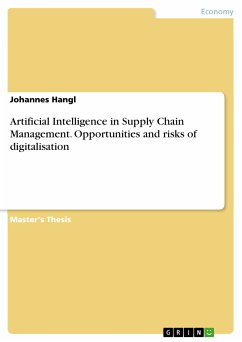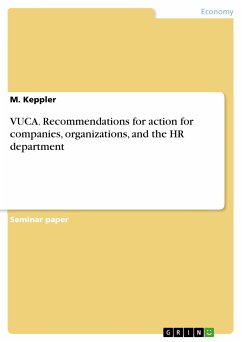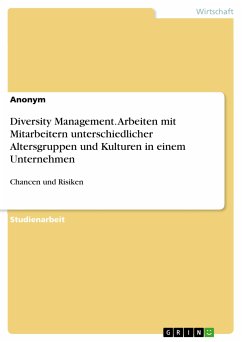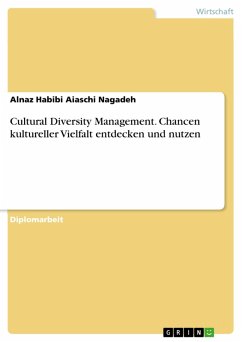
Diversity Management. Opportunities, risks and options for action (eBook, PDF)

PAYBACK Punkte
0 °P sammeln!
Seminar paper from the year 2014 in the subject Leadership and Human Resources - Miscellaneous, grade: 1,0, AKAD University of Applied Sciences Stuttgart, language: English, abstract: In the course of the Internet and expanded transnational relationships, companies are increasingly acting globally and coming into contact with many cultures, so that diversity is also becoming essential within the corporate structure. In order to be able to react to all these changes flexibly and in line with the market, it is inevitable for companies to deal with diversity management (DiM). The aim of this pape...
Seminar paper from the year 2014 in the subject Leadership and Human Resources - Miscellaneous, grade: 1,0, AKAD University of Applied Sciences Stuttgart, language: English, abstract: In the course of the Internet and expanded transnational relationships, companies are increasingly acting globally and coming into contact with many cultures, so that diversity is also becoming essential within the corporate structure. In order to be able to react to all these changes flexibly and in line with the market, it is inevitable for companies to deal with diversity management (DiM). The aim of this paper is to generate a comprehensive knowledge of DiM as such, to be able to rationally weigh opportunities and risks and to derive from this the various options for action of the respective dimensions of diversity. know. In order to establish the knowledge base required for this purpose, chapter 2.1 deals with the terms diversity and management. Building on this, Chapter 2.2 outlines the opportunities and risks for companies associated with implementing the DiM concept. With this background knowledge, the four-level model according to Gardenswatz and Rowe is presented in the following chapter 2.3 to illustrate the complex topic. In connection with the acquired knowledge of the different levels, chapter 2.4 switches to the operational level and presents concrete options for action within the framework of the DiM concept. In the conclusion, the findings are summarized, followed by a critical examination of the assignment. Finally, an outlook on possible changes is given.
Dieser Download kann aus rechtlichen Gründen nur mit Rechnungsadresse in A, B, BG, CY, CZ, D, DK, EW, E, FIN, F, GR, HR, H, IRL, I, LT, L, LR, M, NL, PL, P, R, S, SLO, SK ausgeliefert werden.













